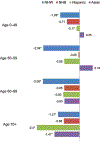Recent Trends in Ovarian Cancer Incidence and Relative Survival in the United States by Race/Ethnicity and Histologic Subtypes
- PMID: 28751475
- PMCID: PMC6859937
- DOI: 10.1158/1055-9965.EPI-17-0290
Recent Trends in Ovarian Cancer Incidence and Relative Survival in the United States by Race/Ethnicity and Histologic Subtypes
Abstract
Background: Incidence and survival rates of nonserous epithelial ovarian cancer in racial/ethnic minorities remain relatively unknown in the United States. We examined the trends in incidence and survival rates for epithelial ovarian cancer by histologic subtypes and race/ethnicity.Methods: Ovarian cancer incidence and mortality data from 2000 to 2013 were obtained from the Surveillance, Epidemiology, and End Results database. Age-adjusted incidence rate, incidence rate ratio, and annual percentage changes (APC) were calculated by histology and race/ethnicity subgroups and stratified by age at diagnosis. Five-year relative survival rates were calculated by stage and race/ethnicity.Results: A small but significant decrease in incidence rates was seen in non-Hispanic white (NHW), non-Hispanic black (NHB), and Hispanic women (APC -1.58, -0.84, and -1.31, respectively), while incidence rates remained relatively stable in Asian women (APC -0.37). With exception of significant increase in the incidence rate of clear cell carcinoma among Asian woman (APC 1.85), an overall trend toward decreasing incidence rates was seen across histologic subtypes and age-strata, although not all results were statistically significant. Compared with NHW women, NHB women experienced poorer 5-year survival at every stage across histologic subtypes, while Hispanic and Asian women had equivalent or better survival.Conclusions: Over the last decade, incidence rates of epithelial ovarian cancer in the United States have decreased or remained stable across race/ethnic and histologic subgroups, except for clear cell carcinoma. Survival remains poorest among NHB women.Impact: Comparative histologic subtype distribution and incidence trends do not explain the ovarian cancer survival disparity disproportionately affecting NHB women. Cancer Epidemiol Biomarkers Prev; 26(10); 1511-8. ©2017 AACR.
©2017 American Association for Cancer Research.
Conflict of interest statement
Disclosure of Potential Conflicts of Interest
No potential conflicts of interest were disclosed.
Figures



Similar articles
-
Incidence Trends of Breast Cancer Molecular Subtypes by Age and Race/Ethnicity in the US From 2010 to 2016.JAMA Netw Open. 2020 Aug 3;3(8):e2013226. doi: 10.1001/jamanetworkopen.2020.13226. JAMA Netw Open. 2020. PMID: 32804214 Free PMC article.
-
The Growing Burden of Endometrial Cancer: A Major Racial Disparity Affecting Black Women.Cancer Epidemiol Biomarkers Prev. 2015 Sep;24(9):1407-15. doi: 10.1158/1055-9965.EPI-15-0316. Epub 2015 Aug 19. Cancer Epidemiol Biomarkers Prev. 2015. PMID: 26290568
-
Racial and ethnic disparities in gallbladder cancer: A two-decade analysis of incidence and mortality rates in the US.Cancer Med. 2024 Jul;13(13):e7457. doi: 10.1002/cam4.7457. Cancer Med. 2024. PMID: 38963040 Free PMC article.
-
Racial/ethnic disparities in ovarian cancer research.Adv Cancer Res. 2020;146:1-21. doi: 10.1016/bs.acr.2020.01.002. Epub 2020 Feb 24. Adv Cancer Res. 2020. PMID: 32241384 Review.
-
Ovarian cancer. Age contrasts in incidence, histology, disease stage at diagnosis, and mortality.Cancer. 1993 Jan 15;71(2 Suppl):517-23. doi: 10.1002/cncr.2820710205. Cancer. 1993. PMID: 8420671 Review.
Cited by
-
Nanoparticle-Based Follistatin Messenger RNA Therapy for Reprogramming Metastatic Ovarian Cancer and Ameliorating Cancer-Associated Cachexia.Small. 2022 Nov;18(44):e2204436. doi: 10.1002/smll.202204436. Epub 2022 Sep 13. Small. 2022. PMID: 36098251 Free PMC article.
-
An analysis of clinical characteristics and prognosis of endometrioid ovarian cancer based on the SEER database and two centers in China.BMC Cancer. 2023 Jul 1;23(1):608. doi: 10.1186/s12885-023-11048-1. BMC Cancer. 2023. PMID: 37391693 Free PMC article.
-
Tubal ligation and ovarian cancer risk in African American women.Cancer Causes Control. 2017 Oct;28(10):1033-1041. doi: 10.1007/s10552-017-0943-6. Epub 2017 Sep 4. Cancer Causes Control. 2017. PMID: 28871344 Free PMC article.
-
Outcomes and Prognostic Factors of Patients with Platinum- Resistant or Refractory Epithelial Ovarian Cancer, Fallopian Tube Cancer and Peritoneal Cancer.Asian Pac J Cancer Prev. 2023 Apr 1;24(4):1401-1405. doi: 10.31557/APJCP.2023.24.4.1401. Asian Pac J Cancer Prev. 2023. PMID: 37116164 Free PMC article.
-
Racial Differences in Population Attributable Risk for Epithelial Ovarian Cancer in the OCWAA Consortium.J Natl Cancer Inst. 2021 Jun 1;113(6):710-718. doi: 10.1093/jnci/djaa188. J Natl Cancer Inst. 2021. PMID: 33252629 Free PMC article.
References
-
- Siegel RL, Miller KD, Jemal A. Cancer statistics, 2016. CA Cancer J Clin 2016;66:7–30. - PubMed
-
- Howlader N, Noone AM, Krapcho M, Miller D, Bishop K, Altekruse SF, et al. SEER Cancer Statistics Review, 1975–2013, National Cancer Institute; Bethesda, MD, http://seer.cancer.gov/csr/1975_2013/, based on November 2015 SEER data submission, posted to the SEER website, April 2016.
-
- Sopik V, Iqbal J, Rosen B, Narod SA. Why have ovarian cancer mortality rates declined? Part I. Incidence. Gynecol Oncol 2015;138:741–9. - PubMed
-
- Gnagy S, Ming EE, Devesa SS, Hartge P, Wittemore AS. Declining ovarian cancer rates in U.S. women in relation to parity and oral contraceptive use. Epidemiology 2000;11:102–5. - PubMed
-
- Beral V, Doll R, Hermon C, Peto R, Reeves G. Ovarian cancer and oral contraceptives: collaborative reanalysis of data from 45 epidemiological studies including 23,257 women with ovarian cancer and 87,303 controls. Lancet 2008;371;303–14. - PubMed
MeSH terms
Grants and funding
LinkOut - more resources
Full Text Sources
Other Literature Sources
Medical

